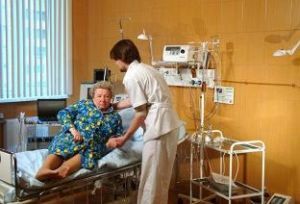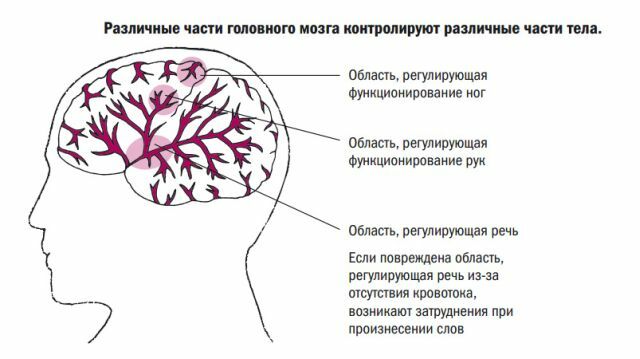By correctly performed first aid for stroke depends on the ability to restore damaged areas of the brain and the normal execution of the functions of the nervous system.

How to identify a stroke
Under acute stroke understand form impaired blood flow in the brain, which causes damage and death of nerve cells.
Strokes occur in people 20 years and older. Allocate 2 varieties:
- in ischemic stroke are narrowed or occluded blood vessels of the brain;
- in hemorrhagic bleeding begins in this zone.
Vascular problems can be assumed on such grounds:
- numbness of the face, arms or legs;
- headache, dizziness;
- loss of control over the situation;
- nausea, vomiting;
- double objects in the eyes, and other visual problems;
- problems with motor activity, sensory disorders.

Stroke appears sharply, but there are harbingers:
- headaches, and their exact location to feel wrong, they may occur because of fatigue or when meteozavisimosti;
- noise in ears;
- dizziness, both at rest and during movement;
- memory problems;
- trouble sleeping;
- malfunction.
Be sure to conduct a test with the victims:
- Ask the person to smile. Face will look unusual. If one corner of his mouth does not rise, it is an insult.
- Ask raise both arms. If one has weakened, and it is impossible to keep, it, too, points to the pathology.
- Ask the person to utter his own name. If we are slurred or the victim can not say anything, then it is also stroke indication. A man will talk unusual, difficult, strange.

When symptoms of pathology identified in stroke care is conducted immediately. It is important to as quickly as possible to call a medical team. The doctors have only 3 hours (maximum 4.5 hours) in order to save human stroke.
During the therapeutic window (which is only 3-6 hours after a stroke), you can prevent serious complications and death of tissue ischemia special therapeutic manipulation.
The correct position
Stroke first aid involves giving the victim the right body position. You need to provide patient comfort, it is forbidden to move. It is best to put the patient on his back and lifted his head a little (if he lost consciousness).
When a patient fainting or convulsions, you should lay it horizontally on its side.
The use of medicines
When the medical team is called, first aid does not involve the use of special drugs.
But if the injured to hospital transportation process is strongly tightened, then to help the brain is administered intravenously such medicaments: Aktovegin, L-lysine, Furosemide, Cortexin, nootropics, Tiotsetam, Piracetam. This is one of the emergency measures for stroke.

First aid
Until the arrival of an ambulance is required to begin the first steps at home to improve the patient's condition. Provide first aid for stroke should be possible to correct:
- Calm and assess the general condition of the patient. Help begins with determining the frequency of breathing, heart rate and the presence of consciousness.
- Call the ambulance, her to come as soon as possible. By phone to specify all of the data on the whereabouts of the victim, fast and clear voice to describe the situation.
- If the patient is conscious, it is necessary to calm him, to assure you that will help him. We can not allow the strong unrest, as stress will aggravate the condition.
- Resuscitation (artificial respiration, heart massage) stroke is carried out only when necessary.
- The patient lay flat on your back or on your side and raise his head.
- Open windows for the flow of oxygen to ease breathing.
- Keep the standing of the victim. If the patient is on the street, it is necessary to hide the warm clothes, to rub the hands and feet.
All actions will facilitate the patient's condition, prevent the development of complications (paralysis, death). It is best to involve the affected several people. If it has a phone, it is recommended to call a few numbers and notify relatives or friends.
when the mini-strokes
Help in this stroke before the ambulance should be the same as described above. Under such a condition to understand the violation of blood flow in the brain. signs microstroke following:
- increased sensitivity to sounds;
- fear of light;
- blurred vision;
- hearing problems;
- raising blood pressure;
- drowsiness and weakness.

In ischemic stroke
Determine that it is an ischemic stroke may be on such grounds:
- It occurs in the morning or at night when the person is at rest;
- the victim consciousness is preserved, general broken, but in a moderate way;
- have problems with speech, weakness of the limbs on one side, the face warps;
- no cramps.
Ischemic form of the disease is dangerous, so the pre-medical aid in stroke involves calling neurologic brigade. On the phone, you must promptly report suspicions about the state of the patient.
Do's and Don'ts to visit specialists:
- Lay the victim so that the shoulders and head were raised.
- Cause the patient to consciousness. You can use ammonia or wine vinegar. It is required to moisten the cotton wool in the solution and bring it to my nose.
- We can not allow sticking of language. Make sure that it was breathing.
- Prohibited give the patient drugs (except glycine and piracetam).
- Hide feet to be warm.

Also, the patient is recommended to wipe the face with cool water and a soft brush to rub the hands and feet.
In hemorrhagic stroke
Hemorrhagic form of the disease can be identified by such attributes:
- It appears when severe physical or mental fatigue;
- the person loses consciousness;
- there are convulsions in most cases;
- neck muscles tense, people can not bend his head;
- increased blood pressure.
If the patient has hemorrhagic form, the first stroke care at home will be the same as in the previous algorithm of actions. But there are some features. In such a disease state worsens, so it is advisable to do all the action as quickly as possible.
If the patient has a hemorrhagic stroke, first aid is as follows:
- Put a man, so that his head and shoulders were above the body.
- Do not allow the victim movement.
- Remove and clean all parts of pressing clothes, unbutton, thus facilitating breathing.
- If inserted in the mouth dentures, they are supposed to be removed.
- Tilt your head to the victim.
- Applied to the patient's head cold compress, but only to the area where there is no numbness.
- Hide the legs so that they are warm.
- Rubbing limbs. This is best done with a mixture of alcohol and oil.

Such action will facilitate the state of the victim, to prevent complications.
Emergency first aid
First aid for stroke is important. But the patient is required and qualified actions of doctors. From the hospital door to the initiation of therapy has at least 1 hour.
follow these steps:
- The patient comes to the emergency department.
- Less than 10 minutes is given to the medical examination, test collection, ECG.
- Less than 5 minutes to have examined by a neurologist, intensive care doctors notice.
- 10 minutes spent on the computer of a brain scan.
- 20 minutes diverted to estimate computed tomography and laboratory results.
- After another 15 minutes maximum is intensive care.
When the ambulance arrives, it is doing everything to maintain or restore breathing victim. Emergency aid from doctors is the use of special medicines.
Most often used Semaks (Solution with concentration 1%). In addition to this means of ambulance doctors introduce additional medications to achieve maximum impact as quickly as possible.



